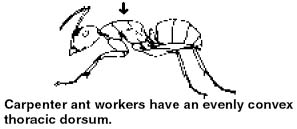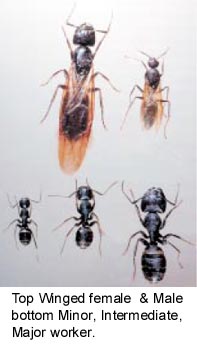|
The Carpenter ant is one
of the most destructive structural pests in the northwest United
States.
Identification
 Carpenter Ants have a
evenly curved "thoracic dorsum", this is the back of the insect.
One of the most common member of this family is
Modoc, it is black with reddish colored legs, but color is not a good
indicator as some types have red parts. These are often found moving along foraging lines about 1 foot apart Trees, fences and firewood are all
regular paths for that they are known to use. Carpenter Ants have a
evenly curved "thoracic dorsum", this is the back of the insect.
One of the most common member of this family is
Modoc, it is black with reddish colored legs, but color is not a good
indicator as some types have red parts. These are often found moving along foraging lines about 1 foot apart Trees, fences and firewood are all
regular paths for that they are known to use.
Damage
in the Home
Carpenter ants will damage homes by nesting in them. The
will dig out tunnels to in wood expand their living spaces and can
lead to structural damage. They infestation in the home usually
is a satellite colony, with the main one with in a hundred years
or more in a stump or other decayed wood. When colonies
start establish them selves in homes, they may start small, few
hundred members but can grow to several tens of thousands.
There can be 20 or more satellite colonies.
Making your Home Resistant to Carpenter
Ants
Stumps, fire wood:
Take care when storing firewood. This is a favorite nesting
location for Carpenter ants. Always keep wood elevated
and covered from the rain. A wet pile of firewood in contact
with the ground is an ideal infestation location. Stumps
left in the yard are common locations for colonies.
Landscaping:
Never allow plants to make contact with
the home. Trees and shrubs provide natural paths for insects
and are frequently foraging sites. Wood/Soil
contact:
It is a conducive condition for pests when wood touches
soil. Wood should rest on concrete or other suitable
support, and when it is in direct contact with the ground pressure
treated lumber is recommended. Beauty bark or other
landscaping is often piled too high next to homes. this can
lead to rot/decay and lead to a carpenter ant infestation.
Ventilation:
Crawlspaces and attics need adequate ventilation to keep the
moisture content low. It the ventilation is not adequate,
there will be biogrowth (mold, mildew or fungus) and create
conditions that encourage infestations. Vapor barriers are recommended
in crawlspaces. This will hepl keep the framing under the
home dry and provide a barrier to discourage pests.
Points of Entry:
Check for holes in the exterior of the home, where pipes
and electrical wires enter. doors, windows, foundation cracks,
siding and trim are all common locations for ants. Sealing
these with caulk or other suitable materials to discourage
entry.
Source:
Read more about Carpenter ants
their control
WSU Extension Bulletin 0818.CARPENTER ANTS: THEIR BIOLOGY AND CONTROL,
L. D. Hansen.
Carpenter
Ant Update, PCT Magazine April 2002, L. D. Hansen.
|